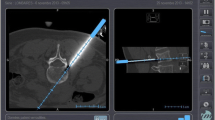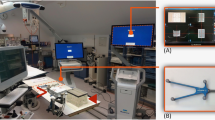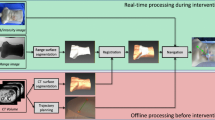Abstract
Purpose
The present study was designed to evaluate the geometrical accuracy and clinical applicability of a new, free-hand, CT-guided, optical navigation system.
Methods
Fifteen procedures in 14 consecutive patients were retrospectively analyzed. The navigation system was applied for interventional procedures on small target lesions, in cases with long needle paths, narrow access windows, or when an out-of-plane access was expected. Mean lesion volume was 27.9 ml, and mean distance to target measured was 107.5 mm. Eleven of 15 needle trajectories were planned as out-of-plane approaches regarding the axial CT plane.
Results
Ninety-one percent of the biopsies were diagnostic. All therapeutic interventions were technically successful. Targeting precision was high with a mean distance of the needle tip from planned target of 1.98 mm. Mean intervention time was 1:12 h. A statistically significant correlation between angular needle deviation and intervention time (p = 0.007), respiratory movement of the target (p = 0.008), and body mass index (p = 0.02) was detected. None of the evaluated parameters correlated significantly with the distance from the needle tip to the planned target.
Conclusions
The application of a navigation system for complex CT-guided procedures provided safe and effective targeting within a reasonable intervention time in our series.




Similar content being viewed by others
References
Gupta S et al (2004) Various approaches for CT-guided percutaneous biopsy of deep pelvic lesions: anatomic and technical considerations. Radiographics 24(1):175–189
Long BW (2000) Image-guided percutaneous needle biopsy: an overview. Radiol Technol 71(4):335–359; quiz 360-363
Hussain S (1996) Gantry angulation in CT-guided percutaneous adrenal biopsy. Am J Roentgenol 166(3):537–539
Odisio BC, Tam AL, Avritscher R, Gupta S, Wallace MJ (2012) CT-guided adrenal biopsy: comparison of ipsilateral decubitus versus prone patient positioning for biopsy approach. Eur Radiol 22(6):1233–1239
van Sonnenberg E et al (1981) Triangulation method for percutaneous needle guidance: the angled approach to upper abdominal masses. Am J Roentgenol 137(4):757–761
Daly B, Templeton PA (1999) Real-time CT fluoroscopy: evolution of an interventional tool. Radiology 211(2):309–315
Prosch H, Stadler A, Schilling M, Bürklin S, Eisenhuber E, Schober E, Mostbeck G (2012) CT fluoroscopy-guided versus multislice CT biopsy mode-guided lung biopsies: accuracy, complications and radiation dose. Eur J Radiol 81(5):1029–1033
Mirota DJ, Ishii M, Hager GD (2011) Vision-based navigation in image-guided interventions. Annu Rev Biomed Eng 13:297–319
Bale R, Widmann G (2007) Navigated CT-guided interventions. Minim Invasive Ther Allied Technol 16(4):196–204
Schullian P et al (2011) Accuracy and diagnostic yield of CT-guided stereotactic liver biopsy of primary and secondary liver tumors. Comput Aided Surg 16(4):181–187
Rasmus M et al (2007) Robotically assisted CT-based procedures. Minim Invasive Ther Allied Technol 16(4):212–216
Widmann G et al (2010) Respiratory motion control for stereotactic and robotic liver interventions. Int J Med Robot 6(3):343–349
Banovac F et al (2005) Precision targeting of liver lesions using a novel electromagnetic navigation device in physiologic phantom and swine. Med Phys 32(8):2698–2705
Maier-Hein L et al (2008) In vivo accuracy assessment of a needle-based navigation system for CT-guided radiofrequency ablation of the liver. Med Phys 35(12):5385–5396
Lei P et al (2011) Real-time tracking of liver motion and deformation using a flexible needle. Int J Comput Assist Radiol Surg 6(3):435–446
Widmann G et al (2009) Target registration and target positioning errors in computer-assisted neurosurgery: proposal for a standardized reporting of error assessment. Int J Med Robot 5(4):355–365
Stoffner R et al (2009) Accuracy and feasibility of frameless stereotactic and robot-assisted CT-based puncture in interventional radiology: a comparative phantom study. Rofo 181(9):851–858
Appelbaum L et al (2011) Electromagnetic navigation system for CT-guided biopsy of small lesions. Am J Roentgenol 196(5):1194–1200
Carlson SK et al (2005) CT fluoroscopy-guided biopsy of the lung or upper abdomen with a breath-hold monitoring and feedback system: a prospective randomized controlled clinical trial. Radiology 237(2):701–708
Schoth F et al (2010) Evaluation of an interactive breath-hold control system in CT-guided lung biopsy. Rofo 182(6):507–511
Higgins TL, Hearn CJ, Maurer WG (1996) Conscious sedation: what an internist needs to know. Cleve Clin J Med 63(6):355–361
Gupta S, Madoff DC (2007) Image-guided percutaneous needle biopsy in cancer diagnosis and staging. Tech Vasc Interv Radiol 10(2):88–101
Yuan DM et al (2011) Diagnostic efficiency and complication rate of CT-guided lung biopsy: a single-center experience of the procedures conducted over a 10-year period. Chin Med J (Engl) 124(20):3227–3231
Sundaram M et al (1982) Utility of CT-guided abdominal aspiration procedures. Am J Roentgenol 139(6):1111–1115
Syed R, Bishop JA, Ali SZ (2012) Sacral and presacral lesions: cytopathologic analysis and clinical correlates. Diagn Cytopathol 40(1):7–13
Triller J et al (1991) CT-guided biopsy of pelvic masses. Cardiovasc Intervent Radiol 14(1):63–68
Hau A et al (2002) Accuracy of CT-guided biopsies in 359 patients with musculoskeletal lesions. Skeletal Radiol 31(6):349–353
Schubert T et al (2012) CT-guided percutaneous biopsy of a mass lesion in the upper presacral space: a sacral transneuroforaminal approach. Cardiovasc Intervent Radiol 35(5):1255–1257
Conflict of interest
Tilman Schubert, Augustinus L. Jacob, Michele Pansini, David Liu, Andreas Gutzeit, and Sebastian Kos declare that they have no conflict of interest.
Author information
Authors and Affiliations
Corresponding author
Rights and permissions
About this article
Cite this article
Schubert, T., Jacob, A.L., Pansini, M. et al. CT-Guided Interventions Using a Free-Hand, Optical Tracking System: Initial Clinical Experience. Cardiovasc Intervent Radiol 36, 1055–1062 (2013). https://doi.org/10.1007/s00270-012-0527-5
Received:
Accepted:
Published:
Issue Date:
DOI: https://doi.org/10.1007/s00270-012-0527-5




